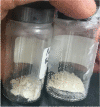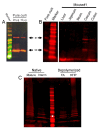Purification of the Bacterial Amyloid "Curli" from Salmonella enterica Serovar Typhimurium and Detection of Curli from Infected Host Tissues
- PMID: 35813019
- PMCID: PMC9183970
- DOI: 10.21769/BioProtoc.4419
Purification of the Bacterial Amyloid "Curli" from Salmonella enterica Serovar Typhimurium and Detection of Curli from Infected Host Tissues
Abstract
Microbiologists are learning to appreciate the importance of "functional amyloids" that are produced by numerous bacterial species and have impacts beyond the microbial world. These structures are used by bacteria to link together, presumably to increase survival, protect against harsh conditions, and perhaps to influence cell-cell communication. Bacterial functional amyloids are also beginning to be appreciated in the context of host-pathogen interactions, where there is evidence that they can trigger the innate immune system and are recognized as non-self-molecular patterns. The characteristic three-dimensional fold of amyloids renders them similar across the bacterial kingdom and into the eukaryotic world, where amyloid proteins can be undesirable and have pathological consequences. The bacterial protein curli, produced by pathogenic Salmonella enterica and Escherichia coli strains, was one of the first functional amyloids discovered. Curli have since been well characterized in terms of function, and we are just starting to scratch the surface about their potential impact on eukaryotic hosts. In this manuscript, we present step-by-step protocols with pictures showing how to purify these bacterial surface structures. We have described the purification process from S. enterica, acknowledging that the same method can be applied to E. coli. In addition, we describe methods for detection of curli within animal tissues (i.e., GI tract) and discuss purifying curli intermediates in a S. enterica msbB mutant strain as they are more cytotoxic than mature curli fibrils. Some of these methods were first described elsewhere, but we wanted to assemble them together in more detail to make it easier for researchers who want to purify curli for use in biological experiments. Our aim is to provide methods that are useful for specialists and non-specialists as bacterial amyloids become of increasing importance.
Keywords: Bacterial Amyloid; Curli; Immunoblotting; Purification; Salmonella.
Copyright © 2022 The Authors; exclusive licensee Bio-protocol LLC.
Conflict of interest statement
Competing interestsThe authors have no competing interests to report.
Figures







Similar articles
-
Cytotoxic Curli Intermediates Form during Salmonella Biofilm Development.J Bacteriol. 2019 Aug 22;201(18):e00095-19. doi: 10.1128/JB.00095-19. Print 2019 Sep 15. J Bacteriol. 2019. PMID: 31182496 Free PMC article.
-
Epithelial cells augment barrier function via activation of the Toll-like receptor 2/phosphatidylinositol 3-kinase pathway upon recognition of Salmonella enterica serovar Typhimurium curli fibrils in the gut.Infect Immun. 2013 Feb;81(2):478-86. doi: 10.1128/IAI.00453-12. Epub 2012 Dec 3. Infect Immun. 2013. PMID: 23208603 Free PMC article.
-
Promiscuous cross-seeding between bacterial amyloids promotes interspecies biofilms.J Biol Chem. 2012 Oct 12;287(42):35092-35103. doi: 10.1074/jbc.M112.383737. Epub 2012 Aug 13. J Biol Chem. 2012. PMID: 22891247 Free PMC article.
-
Curli-Containing Enteric Biofilms Inside and Out: Matrix Composition, Immune Recognition, and Disease Implications.Microbiol Mol Biol Rev. 2018 Oct 10;82(4):e00028-18. doi: 10.1128/MMBR.00028-18. Print 2018 Dec. Microbiol Mol Biol Rev. 2018. PMID: 30305312 Free PMC article. Review.
-
Emerging Roles of Functional Bacterial Amyloids in Gene Regulation, Toxicity, and Immunomodulation.Microbiol Mol Biol Rev. 2020 Nov 25;85(1):e00062-20. doi: 10.1128/MMBR.00062-20. Print 2020 Nov 25. Microbiol Mol Biol Rev. 2020. PMID: 33239434 Free PMC article. Review.
References
-
- Bian Z.,Brauner A.,Li Y. and Normark S.(2000). Expression of and cytokine activation by Escherichia coli curi fibers in human sepsis .J Infect Dis 181(2):602-612. - PubMed
Grants and funding
LinkOut - more resources
Full Text Sources

